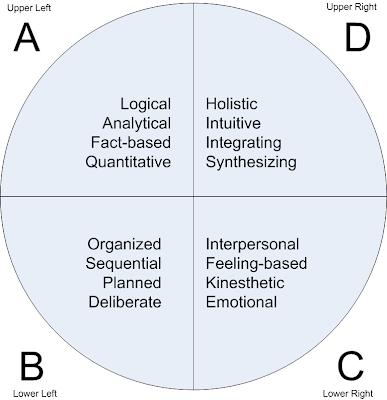"We do not see things as they are, we see things as we are" - The Talmud
Have you noticed that people learn things in different ways? For example, I am a visual learner. I need to see an illustration, photo, or video of something to understand how it works. Someone else might just be able to read a description to understand it. And another person needs to be able to manipulate it before it makes sense to her.
This relates to the concept of Multiple Intelligences and it shows that people have unique learning styles. Courses need to evolve from one-dimensional presentations to a more flexible style that can really reach a broader audience of learners.
The Whole Brain Model
The Whole Brain Model is based on the concept that our different modes of learning are distributed among the four quadrants of the brain. Each quadrant is focused on specific thinking processes. However while you may be stronger in one of the quadrants (I fluctuate between A and D), you have some degree of all quadrant traits in you.
These connections between the four quadrants are there, but they may be weak. So when faced with a learning method that is not a learner's dominant style, there may be uncomfortable, unpracticed or frustrating experiences. On the other end of the spectrum, if you cater only to the dominant learning style, then there is less of a challenge and the training becomes boring.
The idea is to find that balance between boring the learner and anxiety.
Source: Biech, E. (Ed.). (2008). ASTD handbook for workplace learning professionals. Alexandria, VA: ASTD Press.
Aug 1, 2008
Subscribe to:
Post Comments (Atom)



No comments:
Post a Comment